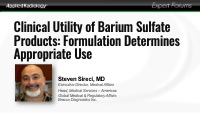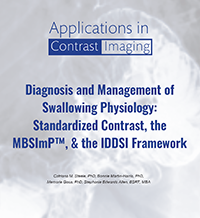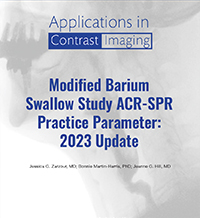Please see a listing of all currently available Barium Online Courses. To select a course, you must be registered and logged-in to this website. Upon registration and/or login, access the online course materials by clicking Select.
Selected courses and all associated program materials will become a permanent part of your User Record and are accessible once logged in.
Supported through an educational grant from Bracco Diagnostics, Inc.
Clinical Utility of Barium Sulfate Products: Formulation Determines Appropriate Use
Authored by:
Steven Sireci, MD
Expiration Date: July 31, 2026
Credits: 0.75
Format:
PDF

Barium-containing contrast media contain barium sulfate (BaSO4), as well as a number of additives. The BaSO4 provides radiodensity (ie, radio-opacity) and physical density (g/mL) to the suspension. Depending on the intended use of the contrast, the specific combination of additives provide other useful properties, including: BaSO4 particle suspension; mucosal coating; viscosity and texture; sweetness; filling and laxative effects; preservation; foaming prevention; and flavoring. Here we describe the purpose of each ingredient and additive found in BaSO4 contrast media products currently available for fluoroscopic and radiographic examinations. In addition, we review the role of these products in anatomic radiographic evaluation of the gastrointestinal (GI) tract and in evaluation of the physiology of swallowing. Finally, we review barium preparations used in computed tomography (CT) applications.
Educational Objectives:
At the completion of this activity, participants should be able to:
-
Explain the role that BaSO4 plays in barium-containing contrast media;
-
Review the purpose of each ingredient/additive found in BaSO4 contrast media products available for fluoroscopic and radiographic examinations;
-
Describe the formulation of barium products that are appropriate for single- and double-contrast anatomic radiographic evaluation of the gastrointestinal (GI) tract;
-
Summarize qualities of the barium-containing contrast media used in evaluation of swallowing that make them most appropriate for that application; and,
-
State the properties of barium-containing contrast media used in computed tomography (CT) applications.
This program has been supported through an educational grant from Bracco Diagnostics, Inc.
|
Clinical Utility of Barium Sulfate Products: Formulation Determines Appropriate Use (OnDemand Webinar)
Authored by:
Steven Sireci, MD
Expiration Date: April 30, 2027
Credits: 1.0
Format:
Webinar

Depending on its intended application in Fluoroscopy or CT, Barium Sulfate (BaSO4) contains specific combinations of additional ingredients that support the diagnosis of disease, define treatment options, and improve patient outcomes. When used for the anatomical evaluation of the GI tract or the physiology of swallowing, a comprehensive understanding of the clinical utility of Barium products and their additives, is needed. This accredited program explains the differences and the benefits of each additive and is designed to increase knowledge about the clinical applications of Barium.
Dr. Sireci will provide a comprehensive overview of each Barium product, its indication and intended use. Following the presentation questions from the audience were addressed in a moderated Q&A session.
Educational Objectives:
At the completion of this activity, participants should be able to:
-
Explain the role that BaSO4 plays in barium-containing contrast media.
-
Review the purpose of each ingredient/additive found in BaSO4 contrast media products currently available for fluoroscopic and radiographic examinations.
-
Describe the formulation of barium products that are appropriate for single and double contrast anatomic radiographic evaluation of the gastrointestinal (GI) tract.
-
Summarize qualities of the barium-containing contrast media used in evaluation of swallowing that make them most appropriate for that application.
-
State the properties of barium-containing contrast media used in computed tomography (CT) applications
This program has been supported through an educational grant from Bracco Diagnostics, Inc.
|
Diagnosis and Management of Swallowing Physiology: Standardized Contrast, the MBSImP™, & the IDDSI Framework
Authored by:
Assorted Faculty
Expiration Date: May 31, 2026
Credits: 1.0
Format:
PDF

Catriona M. Steele, PhD, Bonnie Martin-Harris, PhD, Memorie Gosa, PhD, Stephanie Edwards Allen, BSRT, MBA
The MBSS, also known as a video fluoroscopic swallow study (VFSS), is a barium-sulfate–enhanced fluoroscopic motion study used to evaluate anatomy and swallowing physiology simultaneously in real time. Varibar, an FDA-approved barium sulfate product for evaluation of dysphagia, together with The Modified Barium Swallow Impairment Profile (MBSImP), are used to ensure standardization and reproducibility in the MBSS. This monograph explains the relationship between Varibar, the MBSImP, and the International Dysphagia Diet Standardisation (IDDSI) framework in evaluation of swallowing in clinical practice.
Educational Objectives:
At the completion of this activity, participants should be able to:
-
Explain how the modified barium swallow study (MBSS), The Modified Barium Swallow Impairment Profile (MBSImP), and barium sulfate products are used to evaluate dysphagia
-
Describe the development of FDA-approved barium sulfate products used to assess dysphagia
-
Review the International Dysphagia Diet Standardisation (IDDSI) framework: what it is and how it was developed
-
Define the relationship between the MBSS, the MBSImP, barium sulfate, and IDDSI, and how they are used in clinical practice
-
Summarize pediatric and clinical-practice considerations in performing the MBSS
This program has been supported through an educational grant from Bracco Diagnostics, Inc.
|
Fluoroscopic Evaluation of the Bariatric Surgery Patient
Authored by:
Assorted Faculty
Expiration Date: December 31, 2026
Credits: 1.0
Format:
PDF

Cheri Canon, MD, and Jayleen Grams, MD, PhD
Obesity has been linked to increases in several clinically significant comorbidities. To address these related health issues, the number of bariatric procedures is growing. This monograph describes the role Fluoroscopy plays in the evaluation of the bariatric patient including a review of the imaging protocols and their necessary findings; designed to guide clinical decisions regarding which bariatric procedure is most appropriate for the patient.
Educational Objectives:
At the completion of this activity, participants should be able to:
-
Review the incidence of obesity and the role of bariatric surgery as a strategy to address it
-
Explain the advantages of fluoroscopy in the evaluation of the bariatric patient
-
Summarize the considerations when performing fluoroscopic evaluation of the pre- and post-operative bariatric patient
-
Describe the protocols for fluoroscopic imaging of the gastrointestinal (GI) tract, including single- and dual-phase esophagrams and upper GI examinations
-
Detail the main challenges to performing fluoroscopy in bariatric patients
-
Relate the value of communication between the radiologist and bariatric surgeon
This Program Has Been Supported Through An Unrestricted Educational Grant from Bracco Diagnostics, Inc.
|
Modified Barium Swallow Study ACR-SPR Practice Parameter: 2023 Update
Authored by:
Assorted Faculty
Expiration Date: March 31, 2027
Credits: 1.0
Format:
PDF

Jessica G. Zarzour, MD • Bonnie Martin-Harris, PhD • Jeanne Hill, MD
The modified barium swallow study (MBSS) is a videofluoroscopic imaging study used to evaluate oral and pharyngeal swallowing function and airway protection. The exam is typically performed by a radiologist together with a speech-language pathologist (SLP). The American College of Radiology (ACR) creates and periodically updates Practice Parameters and Technical Standards for various radiologic procedures, including the MBSS. The goal of these Practice Parameters is to “promote the safe and effective use of diagnostic and therapeutic radiology by describing specific training, skills, and techniques,” and to “narrow the variability among radiology practices and provide guidance to achieve quality in radiology.” In 2023, the ACR partnered with the Society of Pediatric Radiology (SPR) to update the MBSS Practice Parameter. The updated ACR-SPR Practice Parameter for the Performance of the Modified Barium Swallow Study is summarized herein.
Educational Objectives:
At the completion of this activity, participants should be able to:
-
Explain how the modified barium swallow study (MBSS), The Modified Barium Swallow Impairment Profile (MBSImP), and barium sulfate products are used to evaluate dysphagia
-
State the clinical benefits and indications for the modified barium swallow study (MBSS);
-
Detail the clinical benefit of standardized, validated protocols and commercially available barium sulfate products to reduce variability of the MBSS exam;
-
Describe the technical and patient considerations associated with the MBSS;
-
Implement the imaging protocol for a standardized MBSS examination;
-
Demonstrate opportunities for improved communication between radiologists and speech-language pathologists.
This program has been supported through an educational grant from Bracco Diagnostics, Inc.
|
The Modified Barium Swallow Study: When, How, and Why?
Authored by:
Assorted Faculty
Expiration Date: September 30, 2026
Credits: 1.0
Format:
PDF

Margaret M. Fynes, MD; Christine Smith, MS; and Martin B. Brodsky, PhD, ScM
Dysphagia is a common clinical challenge, particularly in the elderly. The modified barium swallow study (MBSS), initially developed by radiologists and speech-language pathologists (SLPs) at The Johns Hopkins Hospital, is critically important for evaluation and treatment of dysphagia. In this article, the authors, radiologist Margaret M. Fynes, MD, and two SLPs, Christine Smith, MS, and Martin B. Brodsky, PhD, ScM, review the technical and patient considerations for optimal performance of the MBSS according to The Johns Hopkins protocol. Because both perspectives, radiologist and SLP, are included, the article is able to highlight the importance of the role of each, as well as how they work together. Elements of the MBSS that have become more standardized over time, specifically the barium sulfate contrast agent products used, and the scoring and reporting of the examination with the Modified Barium Swallowing Impairment Profile (MBSImP), are described, and the contribution of this standardization to the overall accuracy and reliability of the MBSS is discussed.
Educational Objectives:
At the completion of this activity, participants should be able to:
-
Review the causes and incidence of dysphagia
-
Describe technical and patient considerations associated with performing a fluoroscopic modified barium swallow study (MBSS) to evaluate dysphagia
-
Explain how the MBSS contributes to the evaluation and treatment of patients with dysphagia by assessing the cause of dysphagia and allowing implementation of compensatory strategies in real-time
-
Explain the importance of the relationship between the radiologist and speech-language pathologist (SLP) during performance of the MBSS >
-
Explain how use of a standardized series of barium sulfate contrast agent products, as well as use of the Modified Barium Swallowing Impairment Profile (MBSImP), have contributed to standardization of the MBSS examination
-
Detail the benefits of MBSS standardization on the robustness and consistency of the examination
This program has been supported through an educational grant from Bracco Diagnostics, Inc.
|